Have you ever come across the term “quark” in a recipe and wondered what it is? Quark is a versatile and creamy soft cheese that can take your recipes to the next level. It is commonly used in both sweet and savory dishes, adding a creamy texture and delicious flavor.
Quark is often referred to as “Germany’s Greek yogurt,” but it has its own unique characteristics. Unlike Greek yogurt, quark is thicker and has a slightly tangy taste. This smooth and spreadable cheese is not only delicious but also packed with essential nutrients.
Table of Contents
Key Takeaways:
- Quark is a creamy soft cheese used in sweet and savory recipes
- It is known as “Germany’s Greek yogurt” but has its own distinct flavor
- Quark is a great source of protein, calcium, vitamins, and probiotics
- It can be used in various ways, such as spreads, bases, and replacements for other ingredients
- Quark can be made at home with simple ingredients and equipment
How to Make Quark Cheese at Home
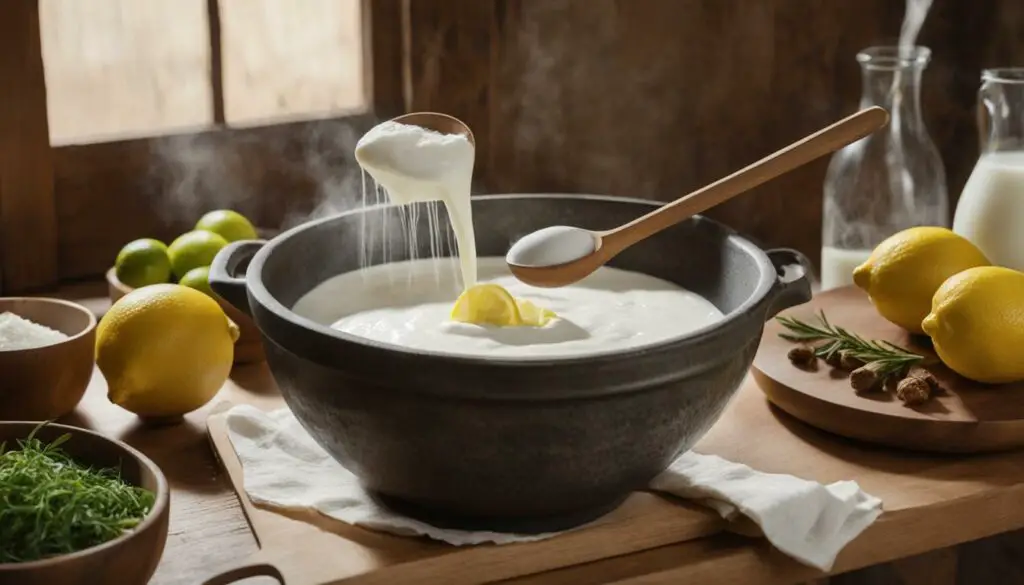
Making quark cheese at home is a cost-effective and delicious option. With just a few simple ingredients and equipment, you can create this creamy and versatile cheese right in your own kitchen.
To make quark, you will need the following:
- A large stainless steel pot
- A skimmer
- Whole milk
- Mesophilic culture
- Calcium chloride
- Liquid rennet
- A thermometer
- Cheesecloth
Follow these steps to make quark cheese:
- Heat the milk to 77°F, slowly and gently, using the stainless steel pot.
- Mix in the mesophilic culture and the appropriate amount of liquid rennet.
- Allow the mixture to sit at room temperature for about 12 hours, until it thickens.
- Strain the thickened milk using the cheesecloth, and let it drain for about 1.5 hours.
- Squeeze out any excess moisture from the cheesecloth.
- Store the quark in an airtight container in the refrigerator. Homemade quark can last for up to two weeks.
Making your own quark cheese gives you full control over the quality and flavor of the final product. It also allows you to experiment with different variations and use the quark in a variety of recipes.
So why not try your hand at making quark cheese at home? It’s a rewarding process that will elevate your cooking and baking endeavors.
Quark in Sweet Recipes
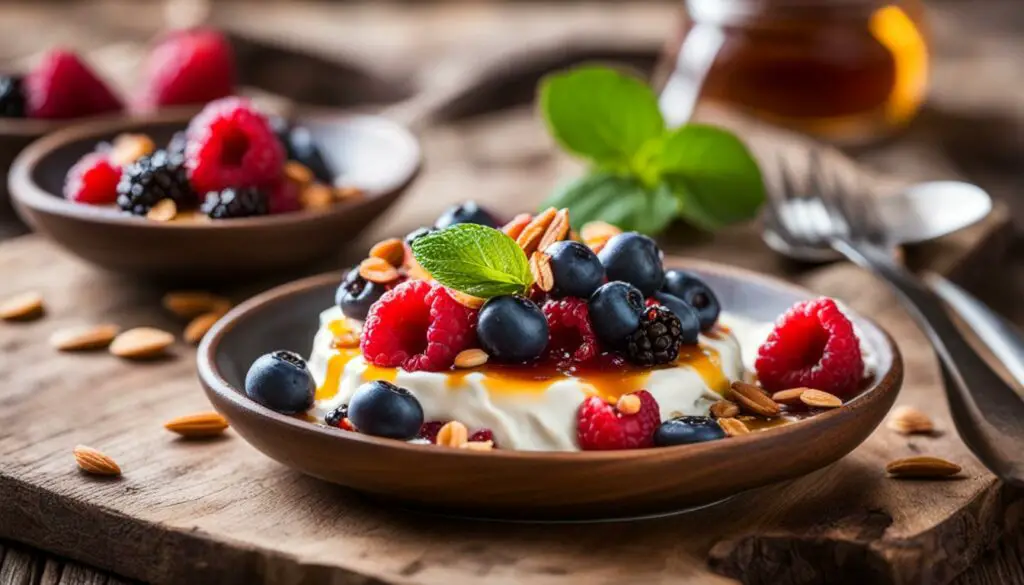
Quark is a fantastic ingredient for creating a wide variety of sweet and indulgent desserts. Its creamy texture and tangy flavor make it the perfect addition to recipes ranging from cheesecakes to fruit parfaits. Quark can be used as a versatile base that pairs well with fruit preserves or fresh fruit for a quick and healthy dessert option.
In addition to being a great standalone ingredient, quark can also be incorporated into muffin, cupcake, or cake batters to enhance their moisture and add a rich, velvety texture. The result is a delectable treat that will have everyone asking for seconds.
In Germany, quark is a traditional ingredient in their famous cheesecake. This creamy and tangy dessert has become a classic, and quark is essential to achieving its unique flavor profile.
Quark is the secret to creating the perfect German cheesecake – creamy, tangy, and absolutely delicious!
From classic recipes to innovative creations, quark opens up a world of possibilities for your sweet tooth. Whether you’re in the mood for a traditional treat or looking to put a unique twist on a dessert, quark is the key ingredient that will take your creations to the next level.
Quark Dessert Ideas
If you’re looking for inspiration, here are some quark dessert ideas to get you started:
- Quark Cheesecake with a graham cracker crust and fresh fruit topping
- Quark Parfait layered with granola and mixed berries
- Quark Fruit Spread to slather on toast or pancakes
- Quark-Filled Muffins with a surprise creamy center
- Quark-Filled Cupcakes topped with luscious buttercream frosting
These are just a few examples of the countless quark dessert possibilities. Let your creativity and taste buds guide you as you experiment with different flavors, textures, and presentations.
Unleash your inner pastry chef and let quark elevate your sweet creations to new heights!
Quark in Savory Recipes

Quark is not only a fantastic ingredient for sweet recipes, but it also shines in savory dishes. Its creamy texture and mild flavor make it a versatile substitute in various recipes, adding a delightful twist to dishes traditionally made with cream cheese, sour cream, or yogurt. Whether you’re looking to create creamy dressings, flavor-packed spreads, or tangy potato toppings, quark has got you covered.
One of the key advantages of quark is its ability to be used as a substitute for cream cheese. Its similar texture and creamy taste make it an excellent option for creamy salad dressings and sauces. Simply swap out the cream cheese for an equal amount of quark in your favorite dressing or sauce recipe and enjoy a lighter, tangier alternative.
If you’re a fan of loaded baked potatoes, quark can take your topping game to the next level. Replace the usual sour cream with a dollop of quark for a luscious and tangy finish. The smooth and velvety quark adds a delightful creaminess that complements the fluffy texture of the potatoes perfectly.
Get creative with quark by mixing it with herbs and garlic to create a delicious spreadable cheese. This flavorful blend can be used as a dip for fresh veggies, a tangy topping for grilled chicken or fish, or even as a spread on your favorite sandwich. The possibilities are endless!
Quark also pairs beautifully with boiled potatoes. Serve it alongside the potatoes for a creamy and satisfying side dish. The combination of the mild, creamy quark and the naturally fluffy potatoes creates a comforting and flavorful experience.
Looking for a quark substitute? No worries! Cream cheese can work as an excellent alternative in many savory recipes. Its creamy texture and slightly tangy flavor make it a suitable replacement for quark. However, keep in mind that the taste and consistency may vary slightly from the original recipe.
Summary: Quark’s creamy texture and mild flavor make it a versatile ingredient in savory recipes. Use it as a substitute for cream cheese in creamy dressings and sauces or add it to baked potatoes for a tangy twist. Get creative by mixing quark with herbs and garlic for a flavorful spread or enjoy it alongside boiled potatoes. Cream cheese can serve as a substitute when quark is unavailable, providing a similar creamy texture and slightly tangy taste.
Examples of Savory Quark Recipes
| Quark Recipe | Description |
|---|---|
| Quark and Herb Spread | A flavorful spread made by mixing quark with fresh herbs such as dill, chives, and parsley. Perfect for spreading on crackers or bread. |
| Creamy Quark and Cucumber Salad Dressing | A refreshing dressing made with quark, cucumber, lemon juice, and dill. Drizzle it over a fresh salad for a light and tangy twist. |
| Tangy Quark-Topped Baked Potatoes | Replace sour cream with quark to create a creamy and tangy topping for baked potatoes. Garnish with chives or bacon for extra flavor. |
| Quark and Garlic Smashed Potatoes | Boiled potatoes mashed with quark and garlic for a flavorful and creamy side dish. Serve it alongside roasted meats or grilled vegetables. |
Health Benefits of Quark
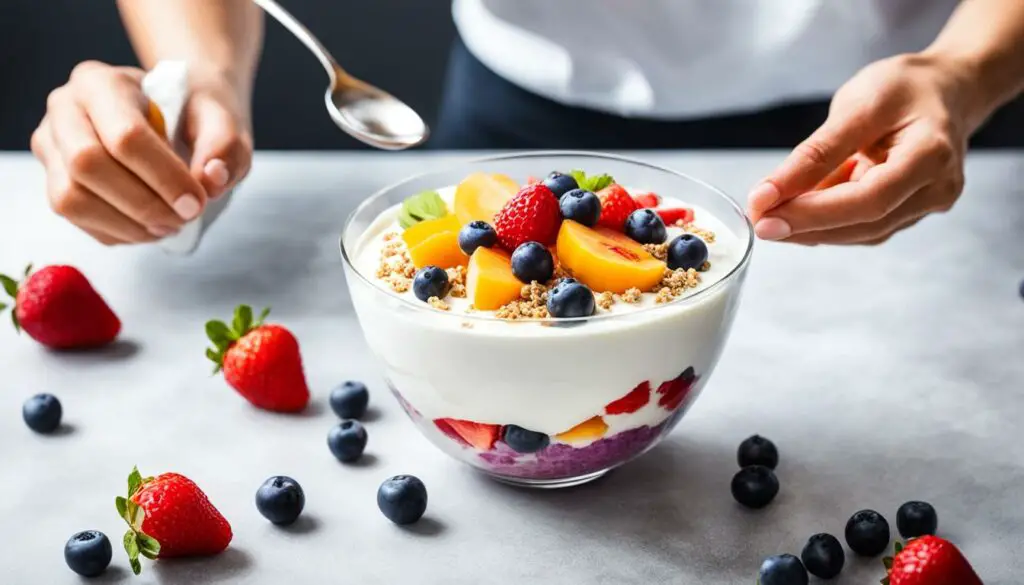
Quark is not only a delicious addition to your recipes, but it also offers numerous health benefits. Its nutrient content makes it a valuable ingredient for maintaining overall well-being. Let’s take a closer look at the benefits of using quark in your recipes.
1. Protein Powerhouse
Quark is a rich source of protein, which is essential for building and repairing tissues in the body. Protein also helps to keep you feeling full and satisfied, making quark a great ingredient for weight management and muscle recovery.
2. Strong Bones and Teeth
Calcium is vital for bone and teeth health, and quark provides a good amount of this mineral. Including quark in your recipes can help maintain strong bones and teeth, reducing the risk of osteoporosis and tooth decay.
3. Essential Vitamins
Quark contains vitamins A and B, which are important for various functions in the body. Vitamin A supports healthy vision, a strong immune system, and cell growth. Vitamin B helps with energy production, brain function, and metabolism.
4. Gut-Friendly Probiotics
Quark contains probiotics, beneficial bacteria that promote a healthy gut microbiome. These probiotics support digestion, improve nutrient absorption, and enhance overall gut health. Including quark in your recipes can contribute to a balanced and harmonious gut environment.
By incorporating quark into your recipes, you can enjoy its creamy texture and delicious taste while reaping the health benefits it provides. Whether you use it in sweet or savory dishes, quark is a versatile and nutritious ingredient that can elevate your meals.
Quark is not only a delicious addition to your recipes, but it also offers numerous health benefits. Its nutrient content makes it a valuable ingredient for maintaining overall well-being.
Quark Substitutes in Recipes

If you can’t find quark or prefer not to use it, there are some suitable substitutes you can use in recipes. Consider the following options:
- Cream cheese: Cream cheese can be a good substitute for quark in both sweet and savory dishes. It provides a similar creamy texture and mild tang.
- Cottage cheese: Cottage cheese can also be used as a substitution for quark, but keep in mind that it has a different texture and flavor profile. Despite this, it can work well depending on the recipe.
- Greek yogurt or sour cream: Greek yogurt or sour cream can be alternatives to quark, depending on the specific recipe. Greek yogurt adds a tangy flavor and creamy texture, while sour cream provides richness and tanginess.
When choosing a quark substitute, it’s important to consider the desired consistency and taste of the final dish. Experiment with different alternatives to find the best option that suits your recipe.
Tips for Using Quark Substitutes:
“When using a quark substitute, it’s a good idea to adjust the other ingredients in the recipe to ensure the desired taste and texture are achieved.”
How to Store Quark
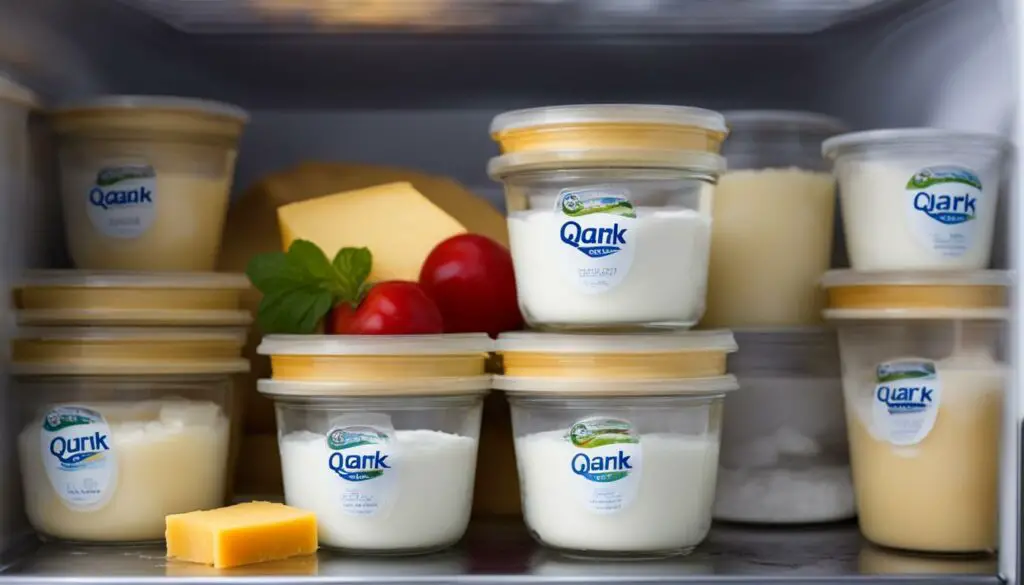
Homemade quark can be stored in an airtight container in the refrigerator for about two weeks. It’s important to keep the quark refrigerated to maintain its freshness and prevent the growth of harmful bacteria.
Freezing quark is possible, but the texture and consistency may change as it thaws. The liquid in the quark may separate, requiring a few good stirs before using it. It’s recommended to consume quark within a reasonable time frame to ensure the best quality.
Tips for Making the Best Quark
To achieve the best results when making quark at home, there are a few tips to keep in mind:
1. Choose the Right Milk
Using whole milk is the best choice for making quark, as it ensures the creamiest texture and fullest flavor. However, if you prefer a lower-fat version, you can use 2% or skim milk instead.
2. Consider Raw Milk
If possible, opt for raw milk when making quark. Raw milk contains natural enzymes and beneficial bacteria that can enhance the fermentation process, resulting in a more flavorful and authentic quark cheese. Pasteurized milk can still be used if raw milk is not available.
3. Add Rennet for Thickening
If using pasteurized milk, adding a small amount of rennet can help it properly thicken during the fermentation process. Rennet is a natural enzyme that aids in curdling the milk and creating the thick and creamy consistency of quark.
4. Use a Real Culture
Instead of using buttermilk as a starter culture, opt for a real culture specifically designed for cheese-making. Real cultures provide a more authentic and nuanced flavor to the quark, enhancing its overall taste and texture.
5. Be Patient
Quark-making requires patience, as the fermentation process can take some time. The time it takes for the milk to thicken can vary depending on the temperature of your home. Be prepared to wait for up to 12 hours or more for the milk to reach the desired consistency.
By following these tips, you can ensure that your homemade quark turns out creamy, flavorful, and delicious. Experiment with different variations and flavors to create your own unique quark recipes and enjoy the satisfaction of making this versatile cheese from scratch.
How to Use Whey (Quark By-Product)
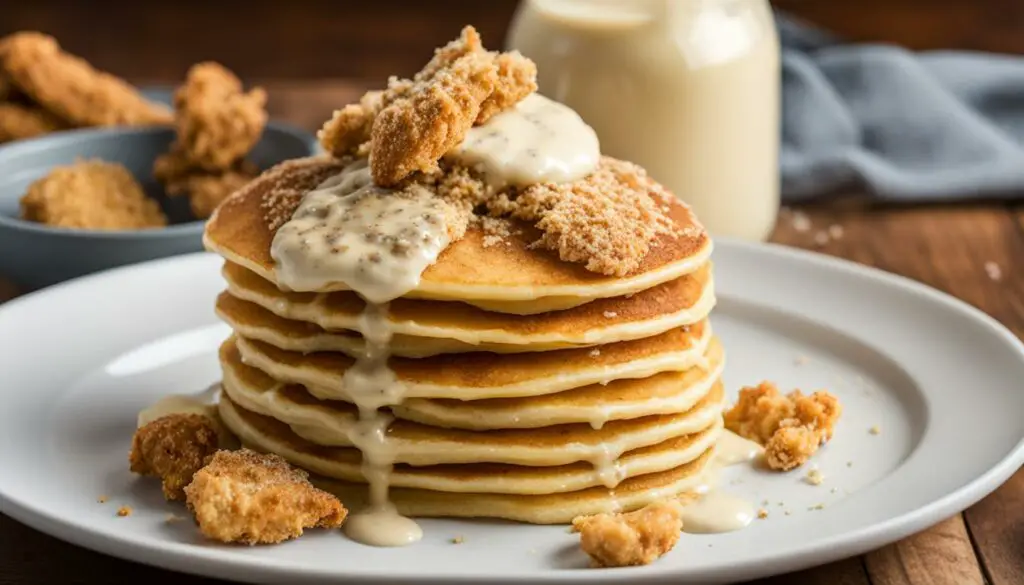
Once you’ve made your homemade quark cheese, you’ll be left with a valuable by-product called whey. Don’t let it go to waste! Whey can be utilized in various ways, adding flavor, moisture, and nutrition to your recipes. Here are some creative ways to use whey:
1. Make Ricotta Cheese
Whey can be transformed into creamy and slightly tangy ricotta cheese. Simply heat the whey to 180°F and add some acid, such as lemon juice or vinegar, to curdle the liquid. Let it cool, then strain the mixture through cheesecloth. The result is homemade ricotta cheese that you can enjoy in lasagnas, stuffed pastas, or as a topping for toast or crackers.
2. Enhance Soups and Broths
Include whey as a base for your homemade soups or broths to enhance their flavor and richness. The whey will add a subtle tanginess that complements savory ingredients. Whether you’re making a hearty vegetable soup, a comforting chicken broth, or a creamy bisque, adding whey will elevate the overall taste.
3. Boost Baked Goods
Utilize whey in your baking to add moisture and a slight tanginess to bread and pastries. Replace some or all of the water or milk in your recipe with whey to infuse your baked goods with extra flavor. Whey is particularly beneficial in artisan bread, muffins, scones, and pancakes. Try it out and enjoy the soft, tender texture it imparts.
4. Power Up Smoothies
Add a protein boost to your smoothies by incorporating whey. Whey protein powder is a popular addition, but using whey from your homemade quark is a natural and nutritious alternative. The whey will provide additional protein, giving your smoothie a creamier consistency and added nutritional value.
5. Acidify Soil for Gardening
For gardening enthusiasts, whey can be a valuable tool in maintaining the pH level of soil for plants that thrive in acidic conditions. Dilute the whey with water and use it to irrigate plants that require a lower pH, such as blueberries, roses, or rhododendrons. This environmentally friendly method can help optimize plant growth and encourage healthy foliage.
Don’t let the whey go to waste! Explore the many possibilities of utilizing this versatile by-product from your quark-making process, from enhancing recipes to enriching your gardening endeavors.
Necessary Equipment for Making Quark
When it comes to making quark at home, you’ll need a few essential pieces of equipment to ensure success. Having the right tools will make the process easier and help you achieve the desired texture and flavor of your homemade quark. Here’s a list of the necessary equipment:
- A large stainless steel pot: This is needed to heat the milk and mix in the culture and rennet. Choose a pot that can comfortably hold the amount of milk you’ll be using.
- A stainless steel skimmer: This tool allows you to draw the culture and rennet into the milk without introducing any contaminants.
- A thermometer: An accurate thermometer is essential for monitoring the temperature of the milk during the heating process. This will help you achieve the optimal temperature for adding the culture and rennet.
- Cheesecloth: Cheesecloth is necessary for straining the thickened milk and removing excess moisture. It allows the liquid to drain away while retaining the creamy quark.
If you plan on making quark or other cheeses frequently, it’s worth investing in these items. They are readily available at kitchen supply stores or online, and they will make your quark-making process much more enjoyable.
Conclusion
Quark is a versatile and creamy cheese that can add a delightful touch to both sweet and savory recipes. With its high protein, calcium, vitamin, and probiotic content, it not only makes your dishes taste great but also provides important nutrients. Making quark at home is a cost-effective option that allows you to tailor the texture and flavor to your liking.
Whether you choose to incorporate quark in desserts, spreads, dressings, or other recipes, it brings a unique creaminess and depth of flavor. Furthermore, quark offers several health benefits and can be used as a substitute for cream cheese in a variety of dishes.
Experiment with different quark recipes to find your favorite way of enjoying this delicious cheese. And don’t forget to explore the potential of quark in creating healthy and tasty meals. Quark truly is a culinary gem that can take your cooking to new heights!
FAQ
What is Quark in a Recipe?
Quark is a versatile, creamy, spreadable soft cheese that is commonly used in both sweet and savory recipes. It is known as “Germany’s Greek yogurt” but is thicker and has a different flavor profile.
How to Make Quark Cheese at Home?
To make quark cheese at home, you will need a large stainless steel pot, a skimmer, whole milk, mesophilic culture, calcium chloride, liquid rennet, a thermometer, and cheesecloth. Heat the milk, mix in the culture and rennet, let it sit until it thickens, strain it using cheesecloth, and store it in the refrigerator.
How to Use Quark in Sweet Recipes?
Quark can be used to create creamy and flavorful desserts like cheesecakes, parfaits, and fruit spreads. It can be mixed with fruit preserves or fresh fruit, added to muffin or cake batters, or used in traditional German cheesecakes.
How to Use Quark in Savory Recipes?
Quark can be used as a substitute for cream cheese in creamy dressings and sauces. It can be added to baked potatoes, mixed with herbs and garlic, or served with boiled potatoes.
What Are the Health Benefits of Quark?
Quark is a great source of protein, calcium, vitamins, and probiotics. It supports tissue repair, maintains strong bones and teeth, promotes overall health, and contributes to a healthy gut microbiome.
What Are the Quark Substitutes in Recipes?
Cream cheese, cottage cheese, Greek yogurt, and sour cream can be used as substitutes for quark, depending on the recipe.
How to Store Quark?
Homemade quark can be stored in an airtight container in the refrigerator for about two weeks.
What Are Tips for Making the Best Quark?
Use whole milk, a real culture instead of buttermilk, and be patient during the thickening process.
How to Use Whey (Quark By-Product)?
Whey can be used to make ricotta cheese, as a base for broth or soup, in baking bread or pastries, or added to smoothies for an extra protein boost.
What Equipment is Necessary for Making Quark?
You will need a large stainless steel pot, a skimmer, a thermometer, and cheesecloth for making quark at home.
Conclusion on Quark in a Recipe
Quark is a versatile and creamy cheese that can elevate both sweet and savory recipes. It offers health benefits and can be substituted if needed. Store quark properly and consider tips when making it at home. Whey is a useful by-product, and specific equipment is required for making quark.
Source Links
- https://www.daringgourmet.com/how-to-make-quark/
- https://cheesemaking.com/products/quark-cheese-making-recipe
- https://www.recipesfromeurope.com/german-quark-recipe/
See also:
Leave a Reply